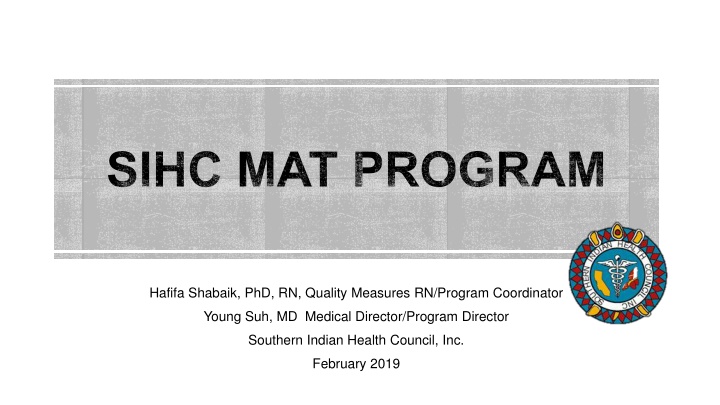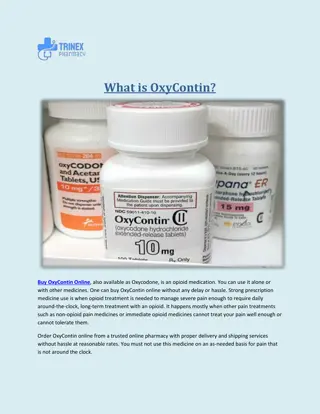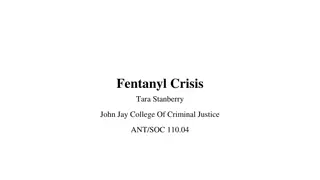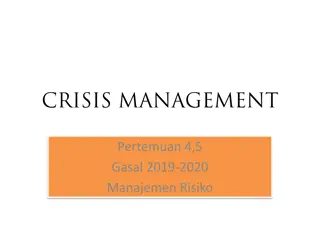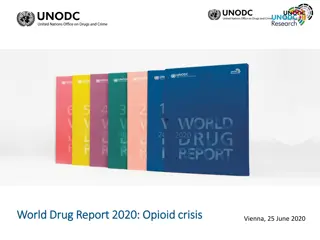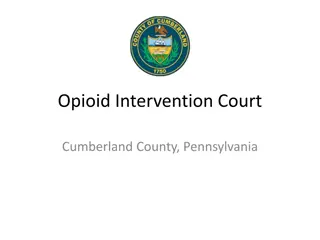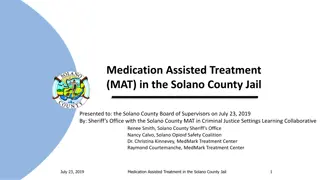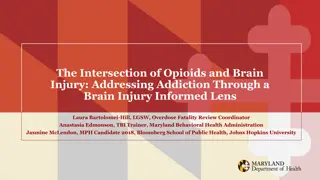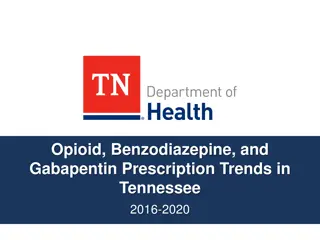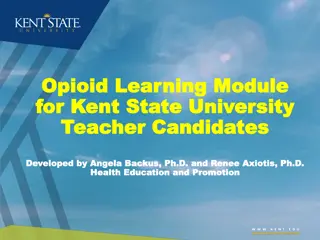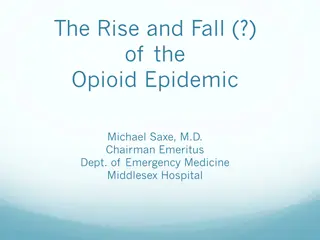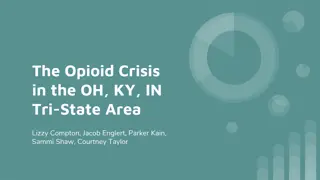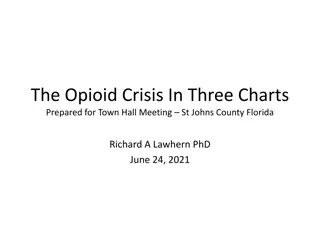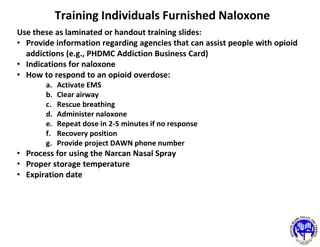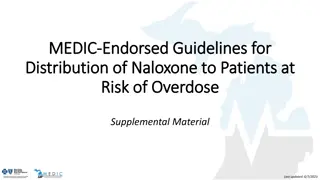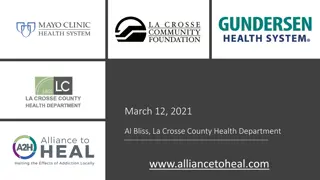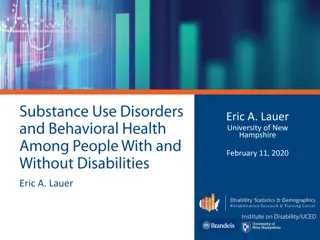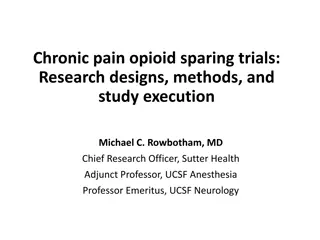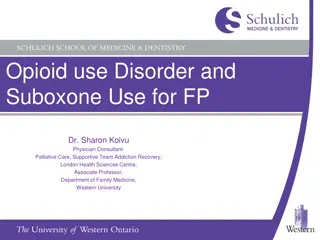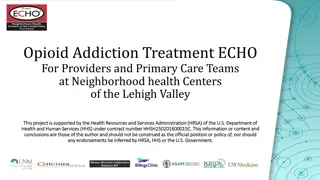Opioid Crisis in the United States: A Growing Epidemic
Drug overdose deaths, particularly related to opioids, have been on the rise in the United States over the years. The misuse and diversion of prescription opioids, coupled with the availability of cheaper illicit alternatives, have led to a significant increase in opioid-related fatalities. This epidemic, fueled by pharmaceutical companies' claims of non-addictiveness and increased opioid prescriptions by healthcare providers, has resulted in a staggering number of deaths, highlighting the urgent need for comprehensive intervention strategies.
Download Presentation

Please find below an Image/Link to download the presentation.
The content on the website is provided AS IS for your information and personal use only. It may not be sold, licensed, or shared on other websites without obtaining consent from the author.If you encounter any issues during the download, it is possible that the publisher has removed the file from their server.
You are allowed to download the files provided on this website for personal or commercial use, subject to the condition that they are used lawfully. All files are the property of their respective owners.
The content on the website is provided AS IS for your information and personal use only. It may not be sold, licensed, or shared on other websites without obtaining consent from the author.
E N D
Presentation Transcript
SIHC MAT PROGRAM Hafifa Shabaik, PhD, RN, Quality Measures RN/Program Coordinator Young Suh, MD Medical Director/Program Director Southern Indian Health Council, Inc. February 2019
DRUG OVERDOSE DEATHS IN THE U.S. Number of Drug Overdose Deaths Per Year 2017 More than 4 times higher than 1999 More than peak HIV deaths in 1995 More than peak gun deaths in 1993 More than peak car crash deaths in 1972 SOURCES: https://www.nytimes.com/interactive/2016/01/07/us/drug-overdose-deaths-in-the-us.html https://www.nytimes.com/interactive/2017/06/05/upshot/opioid-epidemic-drug-overdose-deaths-are-rising-faster-than-ever.html NCHS, National Vital Statistics System, Mortality
OPIOID OVERDOSE DEATHS IN THE U.S. 1999 2016 Drug overdose deaths continue to increase in the United States. From 1999 to 2016: More than 630,000 people have died from a drug overdose. More than 350,000 (56%) people died from an overdose involving any opioid, including prescription and illicit opioids. And 66% in 2016 alone. In 2016, the number of overdose deaths involving opioids (including prescription opioids and illegal opioids like heroin and illicitly manufactured fentanyl) was 5 times higher than in 1999. On average, 115 Americans die every day from an opioid overdose. For American Indians and Alaska Natives, 8.4 per 100,000 experience opioid related fatalities, representing 3 times the death rate for Black Americans and Hispanic Whites. SOURCES: https://www.cdc.gov/drugoverdose/epidemic/index.html
THE OPIOID EPIDEMIC Pharmaceutical Companies Claimed that prescription opioids were not addictive Healthcare System Physicians began to prescribe opioids at greater rates Addictive Properties Misuse, abuse and diversion led to the spread of addiction and opioid overdoses Cheaper Alternatives Illicit manufacturing drastically increasing the number of deaths from opioids. *Roughly 25% of patients misuse prescribed Opioids for chronic pain *80% of Heroin users misused prescription opioids first
OPIOIDS What is an opioid? Derived from opium, that activate opioid receptors, commonly used for pain relief. Includes: Prescription opioids: hydrocodone (Vicodin), oxycodone (OxyContin, Percocet), morphine, codeine, and fentanyl. Illicitly produced opioids: heroin and fentanyl. Opioids used in medication assisted treatments: Methadone and buprenorphine (Suboxone)
DEVELOPING OUD Opioids reduce the sensation of pain broadly and can make a person feel relaxed and produce a state of euphoria. When used for extended time or without medical need, one can 8-12% Of people prescribed opioids for chronic pain develop OUD1. develop opioid dependence/opioid use disorder. Uncontrollable, compulsive drug seeking and use, even in the face of negative health and social consequences. Believed to be associated with the brain s reward pathways (dopamine). Ending the use of opioids can be difficult on one s own. There is no one treatment option best for everyone, but medications are available to assist patients in their path toward wellness and recovery. 1 NIH National Institute on Drug Abuse
SIHC APPROACH safe, effective, non-addictive strategies to manage chronic pain new, innovative medications and technologies to treat opioid use disorders improved overdose prevention and reversal interventionsto save lives and support recovery
MEDICATION-ASSISTED TREATMENT (MAT) Medication Assisted Treatment (MAT) is the use of federally approved medications, in combination with counseling and behavioral health therapies, to provide a whole- patient approach to the treatment of substance use disorders. Opioid Use Disorder Behavioral health Traditional health Social services Wellness Primary care
MAT AT SIHC The Office-Based MAT Program at SIHC is a funded program through the Tribal Opioid Response Grant by the Substance Abuse and Mental Health Services Administration. The goals of the MAT program is to increase access to medication assisted treatment for opioid use disorder in our community by providing: Increasing # providers with DEA waivers Referral to counseling/behavioral health services Care coordination Drug screening Prescription drug monitoring Community outreach and education
(MAT) MEDICATION ASSISTED TREATMENT The use of medications in conjunction with behavioral therapies and counseling to treat substance use disorder and prevent overdose. Medication Methadone Buprenorphine Naltrexone Mechanism Agonist Partial Agonist Antagonist Reduce/eliminate withdrawal symptoms X X Block effects of other opioids X X X Reduce/eliminate opioid cravings X X X
OPIOID OVERDOSE The brain has many receptors for opioids. An overdose occurs when too much of an opioid (heroin, OxyContin, Percocet) fits in too many receptors, stopping the person s breathing. Naloxone has a stronger affinity to the opioid receptors than opioid drugs, so it knocks the opioids off the receptors for a short time. This allows the person to breathe again and reverses the overdose.
CHALLENGES IN MAT Stigma Stigma continues to be the primary obstacle in increasing a community s capacity to address this epidemic. Treatment availability gap Classic forms of treatment and culture may not be supportive
ADRESSING CHALLENGES Stigma Community Outreach and Education at health fairs and events MAT on ROAM Practice non-judgement (educate staff and providers about appropriate language and terms) Treatment availability gap: Encouraging providers at SIHC to obtain DEA waivers to prescribe buprenorphine Collaborating with Kumeyayy Family Services and La Posta Substance Abuse Centers To increase access to counseling Referral to Behavioral Health Services Honoring cultural beliefs and practices By ensuring that our policy and procedures emphasize the community and family, the importance of relationships and respect for clients, especially elders and practice an open-door policy.
References Eidman, M. & Antony, V. (2018). DHCS Tribal MAT Project Powerpoint Presentation. California Consortium for Urban Indian Health. Legha, R., Raleigh-Cohn, A., Fickenscher, A., & Novins, D. (2014). Challenges to providing quality substance abuse treatment services for American Indian and Alaska Native communities: perspectives of staff from 18 treatment centers. BMC psychiatry, 14, 181. Rieckmann, T., Moore, L., Croy, C., Aarons, G. & Novins, D. (2017). National overview of medication-assisted treatment for American Indians and Alaska Natives with substance use disorders. Psychiatric Services, 68(11). Substance Abuse and Mental Health Services Administration (2018). Medication-Assisted Treatment. Retrieved from: https://www.samhsa.gov/medication-assisted-treatment Venner, K. L., Donovan, D. M., Campbell, A., Wendt, D. C., Rieckmann, T., Radin, S. M., Momper, S. L., Rosa, C. L. (2018). Future directions for medication assisted treatment for opioid use disorder with American Indian/Alaska Natives. Addictive Behaviors, 86, 111-117.
